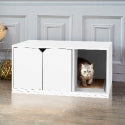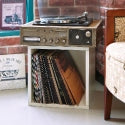
While organizing a kid's bedroom or toy area may sound like child's play, many parents become overwhelmed when trying to create a well-planned playroom that goes beyond fun to include buckets of functionality. But carving out a space that works hard while your little ones play needn't be complicated -- all it takes is a smart container system, a good game plan, and a splash of imagination. Here, I'll share my foolproof "Five Cs" strategy for decorating any children's room.
1. Color: Children's interests change so quickly that dedicating an entire space to a single theme may have you soon redecorating. So rather than a theme (i.e., dinosaurs or princesses) dictating bedroom or playroom plans, allow a bright color scheme to guide your décor and then include hints of hobbies and heroes throughout. To keep your romper room from becoming a rainbow room, let your kids pick their favorite hue for 60 percent of the décor (such as slipcovers, wall paint, and rugs), utilize a neutral for 30 percent (on painted furniture items, for instance), and choose a bold accent color for the remaining 10 (try a spray painted light fixture or playful curtains).
2. Comfort: Include lots of soft surfaces for kids to land on (literally). Don't be afraid to layer rugs, and tuck several pieces of kid-friendly furniture such as beanbag chairs and slip-covered armchairs into cozy nooks. Just be careful not to crowd the space with too much furniture -- you want there to be plenty of room for free play.
3. Cubbies: To help corral the chaos of toys and trinkets, offer loads of cubbies and containers in which goods can be piled and put away. Maximize closet storage space by installing a wire shelving system and wall space by anchoring low bookcases to the wall, then outfit the shelves with canvas or plastic bins. Modular shelving systems also do double-duty as room dividers if your playroom serves a second purpose such as an office.
4. Categories: Make the most of all those cubbies by grouping items into categories like art supplies, music makers, puzzles, books, stuffed animals, and dress-up clothes. Be sure to label your containers with easy-to-understand words or pictures. Finally, organize your containers according to common denominators -- perhaps there's a "playhouse" corner that includes food, dolls, and a toy kitchen and another corner dedicated to quiet activities such as reading, snuggling with stuffed animals, and puzzles.
5. Creative Outlets: Give your kids a place to exercise their imaginations, such as a chalkboard wall or easel and a drawing table to which they can pull up stools for coloring and crafting. And find a place to display your petite Picassos' creations. I like to make a gallery wall using glass-free frames topped with clothespins or a cable system outfitted with clips to showcase artwork on a rotating basis.

What big ideas do you have for your little ones' spaces?
Chris Long has been a Home Depot store associate in the Chicago area since 2000. Chris also contributes on furniture topics to Home Depot's Home Decorators.com website. His home-décor interests include providing home decor closet tips to adding decorative touches to home offices.














